Logistics and Supply Chain Management of Petroleum Development Oman
VerifiedAdded on 2022/08/25
|48
|16570
|20
Report
AI Summary
This report provides a comprehensive analysis of the logistics and supply chain management of Petroleum Development Oman (PDO), one of the largest oil and gas producers. It begins with background information on PDO, its operations, and its challenges, particularly focusing on efficiency and cost reduction. The report identifies the problem statement, research aims, objectives, and questions, setting the stage for an in-depth examination of PDO's supply chain. A thorough literature review explores supply chain management, logistics in the oil industry, and relevant innovations and technologies. The research methodology outlines the research design, data collection methods (primary and secondary), and data analysis processes. The empirical study presents findings from both primary and secondary data sources, followed by an analysis of the current supply chain and potential optimization strategies. The report concludes with recommendations for improving PDO's logistics and supply chain management, addressing challenges, and enhancing overall efficiency in a competitive global environment. The report covers upstream and downstream segments, emphasizing the complexities of transportation, risk management, and the need for flexibility in operational management, with a focus on the downstream segment where there is ample space for optimization.
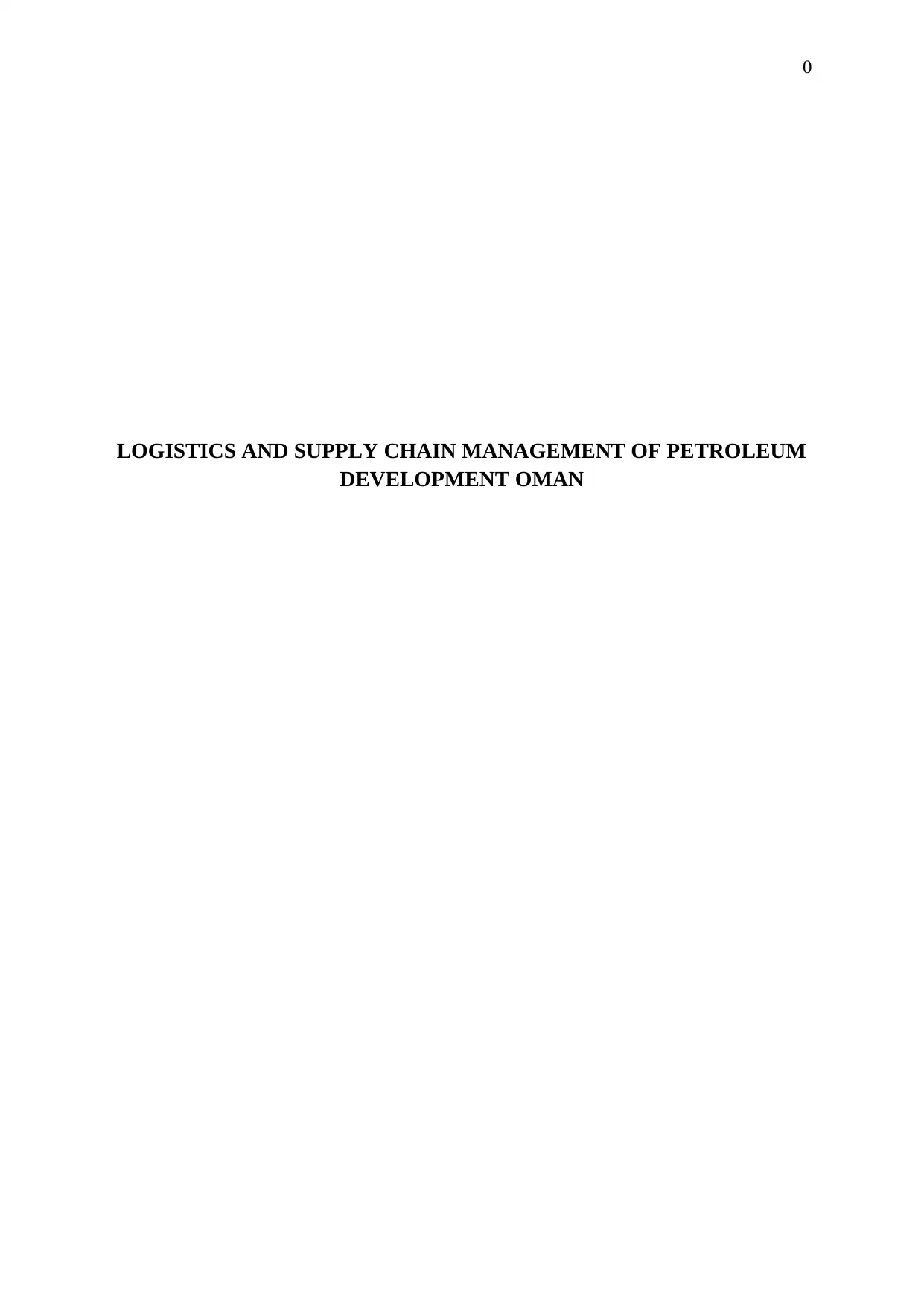
0
LOGISTICS AND SUPPLY CHAIN MANAGEMENT OF PETROLEUM
DEVELOPMENT OMAN
LOGISTICS AND SUPPLY CHAIN MANAGEMENT OF PETROLEUM
DEVELOPMENT OMAN
Paraphrase This Document
Need a fresh take? Get an instant paraphrase of this document with our AI Paraphraser
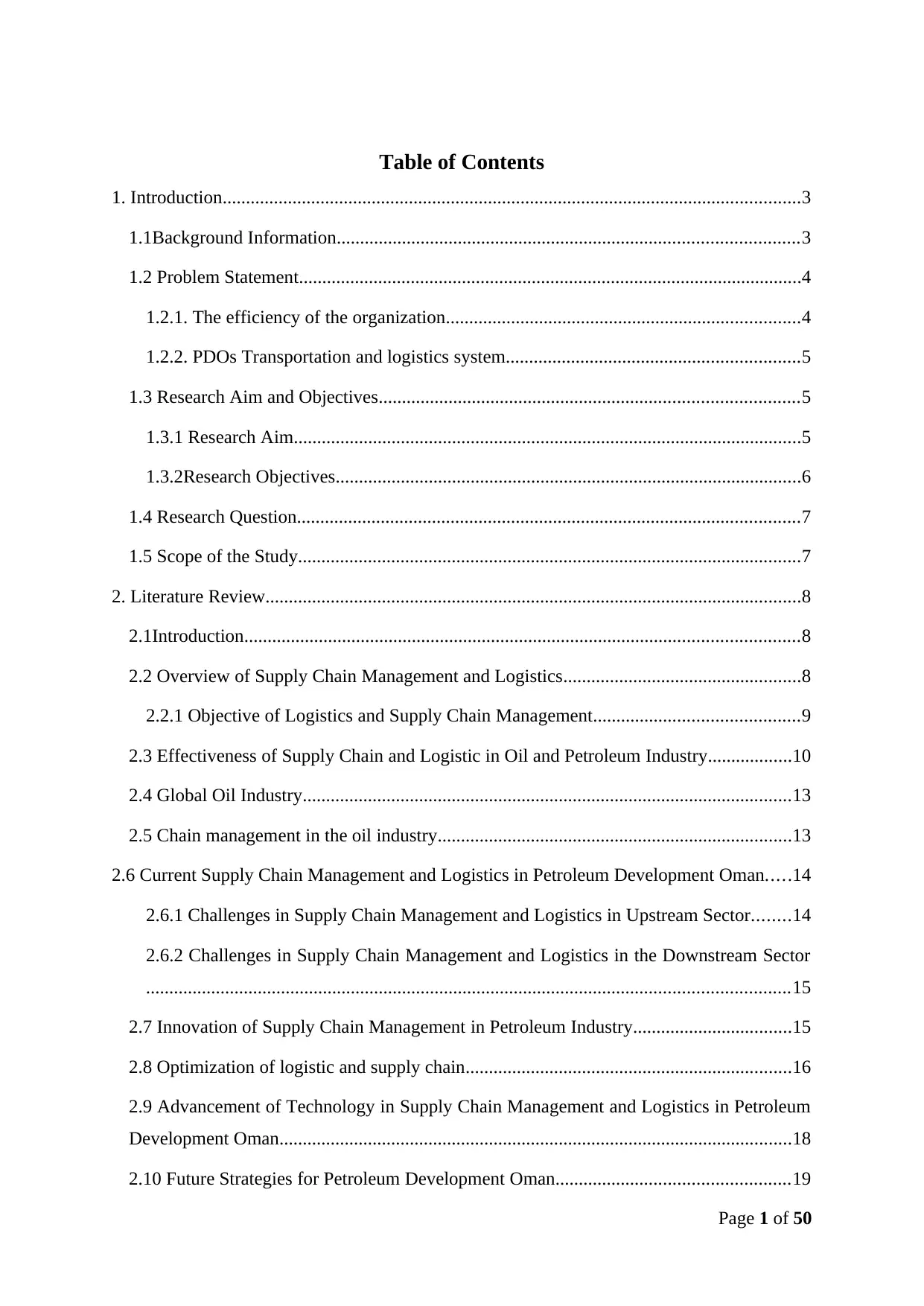
Table of Contents
1. Introduction............................................................................................................................3
1.1Background Information...................................................................................................3
1.2 Problem Statement............................................................................................................4
1.2.1. The efficiency of the organization............................................................................4
1.2.2. PDOs Transportation and logistics system...............................................................5
1.3 Research Aim and Objectives..........................................................................................5
1.3.1 Research Aim.............................................................................................................5
1.3.2Research Objectives....................................................................................................6
1.4 Research Question............................................................................................................7
1.5 Scope of the Study............................................................................................................7
2. Literature Review...................................................................................................................8
2.1Introduction.......................................................................................................................8
2.2 Overview of Supply Chain Management and Logistics...................................................8
2.2.1 Objective of Logistics and Supply Chain Management............................................9
2.3 Effectiveness of Supply Chain and Logistic in Oil and Petroleum Industry..................10
2.4 Global Oil Industry.........................................................................................................13
2.5 Chain management in the oil industry............................................................................13
2.6 Current Supply Chain Management and Logistics in Petroleum Development Oman.....14
2.6.1 Challenges in Supply Chain Management and Logistics in Upstream Sector........14
2.6.2 Challenges in Supply Chain Management and Logistics in the Downstream Sector
..........................................................................................................................................15
2.7 Innovation of Supply Chain Management in Petroleum Industry..................................15
2.8 Optimization of logistic and supply chain......................................................................16
2.9 Advancement of Technology in Supply Chain Management and Logistics in Petroleum
Development Oman..............................................................................................................18
2.10 Future Strategies for Petroleum Development Oman..................................................19
Page 1 of 50
1. Introduction............................................................................................................................3
1.1Background Information...................................................................................................3
1.2 Problem Statement............................................................................................................4
1.2.1. The efficiency of the organization............................................................................4
1.2.2. PDOs Transportation and logistics system...............................................................5
1.3 Research Aim and Objectives..........................................................................................5
1.3.1 Research Aim.............................................................................................................5
1.3.2Research Objectives....................................................................................................6
1.4 Research Question............................................................................................................7
1.5 Scope of the Study............................................................................................................7
2. Literature Review...................................................................................................................8
2.1Introduction.......................................................................................................................8
2.2 Overview of Supply Chain Management and Logistics...................................................8
2.2.1 Objective of Logistics and Supply Chain Management............................................9
2.3 Effectiveness of Supply Chain and Logistic in Oil and Petroleum Industry..................10
2.4 Global Oil Industry.........................................................................................................13
2.5 Chain management in the oil industry............................................................................13
2.6 Current Supply Chain Management and Logistics in Petroleum Development Oman.....14
2.6.1 Challenges in Supply Chain Management and Logistics in Upstream Sector........14
2.6.2 Challenges in Supply Chain Management and Logistics in the Downstream Sector
..........................................................................................................................................15
2.7 Innovation of Supply Chain Management in Petroleum Industry..................................15
2.8 Optimization of logistic and supply chain......................................................................16
2.9 Advancement of Technology in Supply Chain Management and Logistics in Petroleum
Development Oman..............................................................................................................18
2.10 Future Strategies for Petroleum Development Oman..................................................19
Page 1 of 50
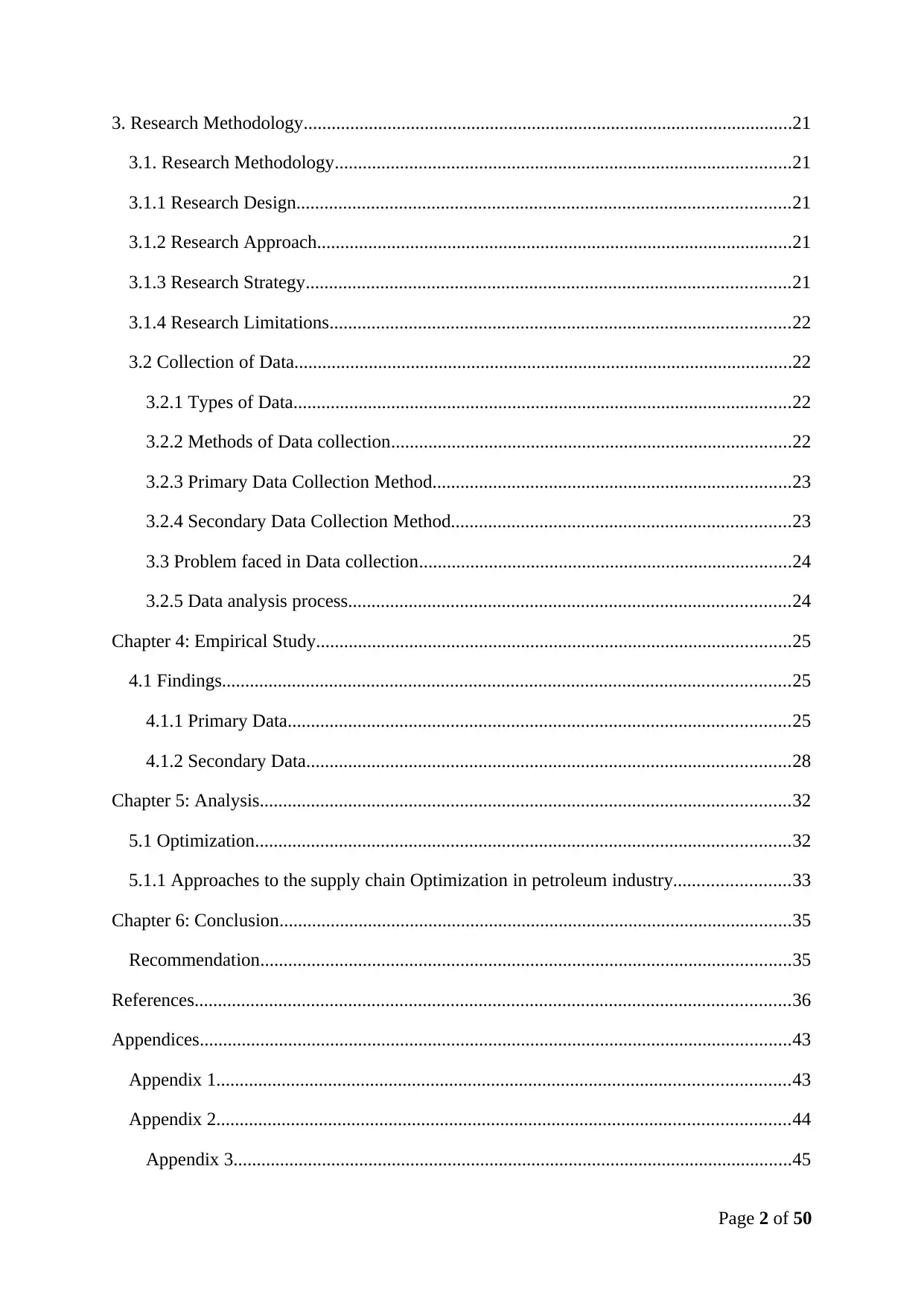
3. Research Methodology.........................................................................................................21
3.1. Research Methodology..................................................................................................21
3.1.1 Research Design..........................................................................................................21
3.1.2 Research Approach......................................................................................................21
3.1.3 Research Strategy........................................................................................................21
3.1.4 Research Limitations...................................................................................................22
3.2 Collection of Data...........................................................................................................22
3.2.1 Types of Data...........................................................................................................22
3.2.2 Methods of Data collection......................................................................................22
3.2.3 Primary Data Collection Method.............................................................................23
3.2.4 Secondary Data Collection Method.........................................................................23
3.3 Problem faced in Data collection................................................................................24
3.2.5 Data analysis process...............................................................................................24
Chapter 4: Empirical Study......................................................................................................25
4.1 Findings..........................................................................................................................25
4.1.1 Primary Data............................................................................................................25
4.1.2 Secondary Data........................................................................................................28
Chapter 5: Analysis..................................................................................................................32
5.1 Optimization...................................................................................................................32
5.1.1 Approaches to the supply chain Optimization in petroleum industry.........................33
Chapter 6: Conclusion..............................................................................................................35
Recommendation..................................................................................................................35
References................................................................................................................................36
Appendices...............................................................................................................................43
Appendix 1...........................................................................................................................43
Appendix 2...........................................................................................................................44
Appendix 3........................................................................................................................45
Page 2 of 50
3.1. Research Methodology..................................................................................................21
3.1.1 Research Design..........................................................................................................21
3.1.2 Research Approach......................................................................................................21
3.1.3 Research Strategy........................................................................................................21
3.1.4 Research Limitations...................................................................................................22
3.2 Collection of Data...........................................................................................................22
3.2.1 Types of Data...........................................................................................................22
3.2.2 Methods of Data collection......................................................................................22
3.2.3 Primary Data Collection Method.............................................................................23
3.2.4 Secondary Data Collection Method.........................................................................23
3.3 Problem faced in Data collection................................................................................24
3.2.5 Data analysis process...............................................................................................24
Chapter 4: Empirical Study......................................................................................................25
4.1 Findings..........................................................................................................................25
4.1.1 Primary Data............................................................................................................25
4.1.2 Secondary Data........................................................................................................28
Chapter 5: Analysis..................................................................................................................32
5.1 Optimization...................................................................................................................32
5.1.1 Approaches to the supply chain Optimization in petroleum industry.........................33
Chapter 6: Conclusion..............................................................................................................35
Recommendation..................................................................................................................35
References................................................................................................................................36
Appendices...............................................................................................................................43
Appendix 1...........................................................................................................................43
Appendix 2...........................................................................................................................44
Appendix 3........................................................................................................................45
Page 2 of 50
⊘ This is a preview!⊘
Do you want full access?
Subscribe today to unlock all pages.

Trusted by 1+ million students worldwide
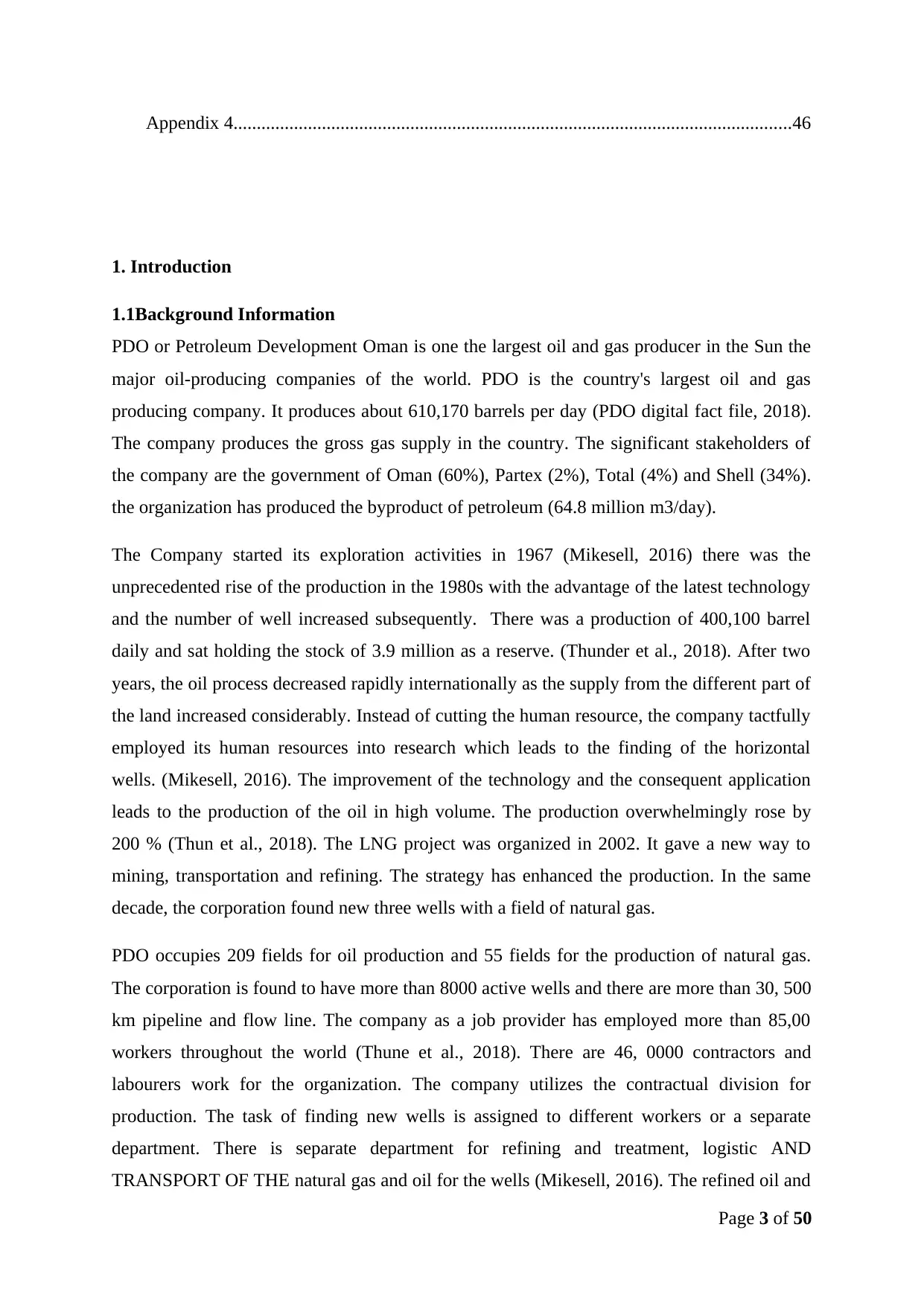
Appendix 4........................................................................................................................46
1. Introduction
1.1Background Information
PDO or Petroleum Development Oman is one the largest oil and gas producer in the Sun the
major oil-producing companies of the world. PDO is the country's largest oil and gas
producing company. It produces about 610,170 barrels per day (PDO digital fact file, 2018).
The company produces the gross gas supply in the country. The significant stakeholders of
the company are the government of Oman (60%), Partex (2%), Total (4%) and Shell (34%).
the organization has produced the byproduct of petroleum (64.8 million m3/day).
The Company started its exploration activities in 1967 (Mikesell, 2016) there was the
unprecedented rise of the production in the 1980s with the advantage of the latest technology
and the number of well increased subsequently. There was a production of 400,100 barrel
daily and sat holding the stock of 3.9 million as a reserve. (Thunder et al., 2018). After two
years, the oil process decreased rapidly internationally as the supply from the different part of
the land increased considerably. Instead of cutting the human resource, the company tactfully
employed its human resources into research which leads to the finding of the horizontal
wells. (Mikesell, 2016). The improvement of the technology and the consequent application
leads to the production of the oil in high volume. The production overwhelmingly rose by
200 % (Thun et al., 2018). The LNG project was organized in 2002. It gave a new way to
mining, transportation and refining. The strategy has enhanced the production. In the same
decade, the corporation found new three wells with a field of natural gas.
PDO occupies 209 fields for oil production and 55 fields for the production of natural gas.
The corporation is found to have more than 8000 active wells and there are more than 30, 500
km pipeline and flow line. The company as a job provider has employed more than 85,00
workers throughout the world (Thune et al., 2018). There are 46, 0000 contractors and
labourers work for the organization. The company utilizes the contractual division for
production. The task of finding new wells is assigned to different workers or a separate
department. There is separate department for refining and treatment, logistic AND
TRANSPORT OF THE natural gas and oil for the wells (Mikesell, 2016). The refined oil and
Page 3 of 50
1. Introduction
1.1Background Information
PDO or Petroleum Development Oman is one the largest oil and gas producer in the Sun the
major oil-producing companies of the world. PDO is the country's largest oil and gas
producing company. It produces about 610,170 barrels per day (PDO digital fact file, 2018).
The company produces the gross gas supply in the country. The significant stakeholders of
the company are the government of Oman (60%), Partex (2%), Total (4%) and Shell (34%).
the organization has produced the byproduct of petroleum (64.8 million m3/day).
The Company started its exploration activities in 1967 (Mikesell, 2016) there was the
unprecedented rise of the production in the 1980s with the advantage of the latest technology
and the number of well increased subsequently. There was a production of 400,100 barrel
daily and sat holding the stock of 3.9 million as a reserve. (Thunder et al., 2018). After two
years, the oil process decreased rapidly internationally as the supply from the different part of
the land increased considerably. Instead of cutting the human resource, the company tactfully
employed its human resources into research which leads to the finding of the horizontal
wells. (Mikesell, 2016). The improvement of the technology and the consequent application
leads to the production of the oil in high volume. The production overwhelmingly rose by
200 % (Thun et al., 2018). The LNG project was organized in 2002. It gave a new way to
mining, transportation and refining. The strategy has enhanced the production. In the same
decade, the corporation found new three wells with a field of natural gas.
PDO occupies 209 fields for oil production and 55 fields for the production of natural gas.
The corporation is found to have more than 8000 active wells and there are more than 30, 500
km pipeline and flow line. The company as a job provider has employed more than 85,00
workers throughout the world (Thune et al., 2018). There are 46, 0000 contractors and
labourers work for the organization. The company utilizes the contractual division for
production. The task of finding new wells is assigned to different workers or a separate
department. There is separate department for refining and treatment, logistic AND
TRANSPORT OF THE natural gas and oil for the wells (Mikesell, 2016). The refined oil and
Page 3 of 50
Paraphrase This Document
Need a fresh take? Get an instant paraphrase of this document with our AI Paraphraser
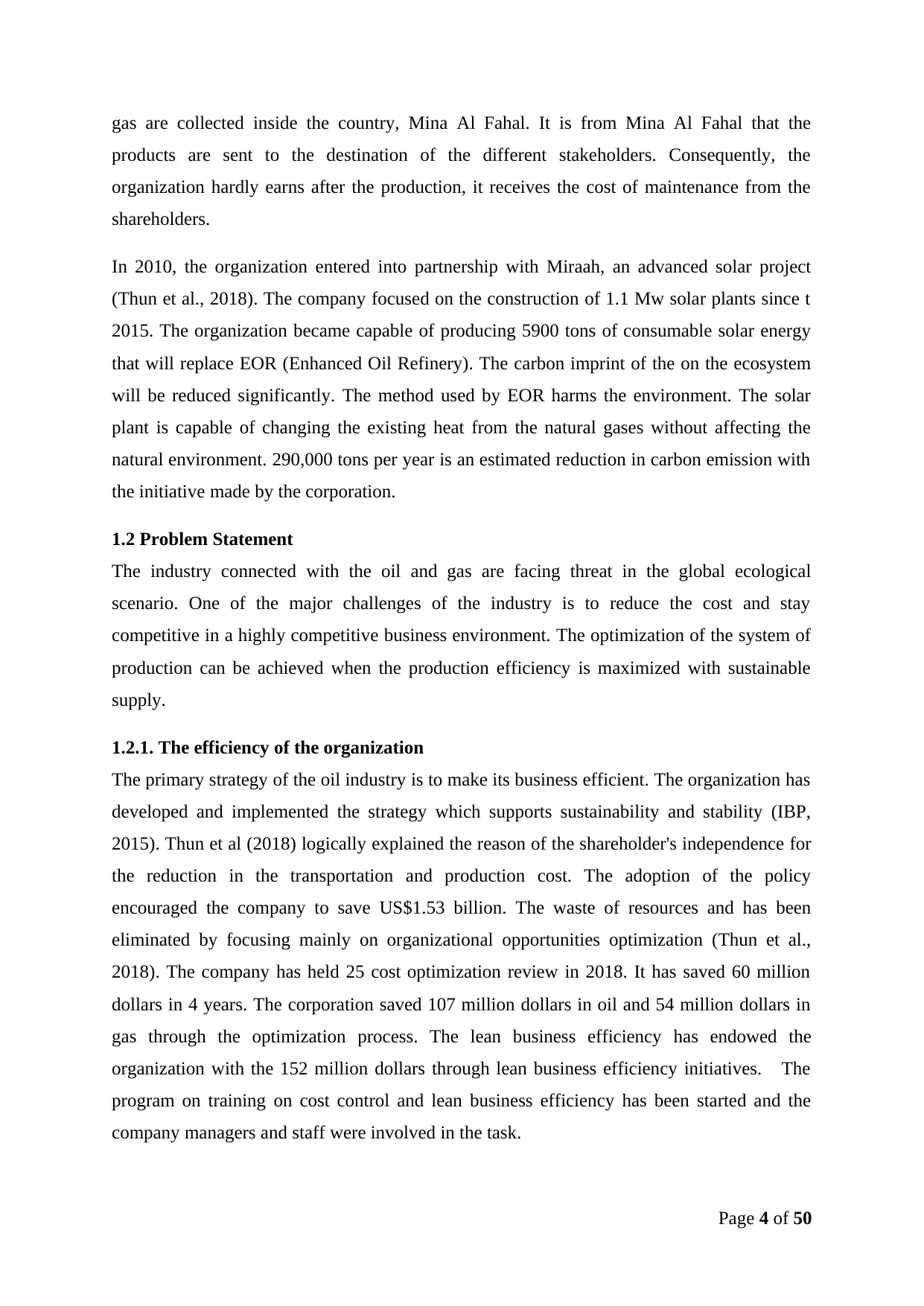
gas are collected inside the country, Mina Al Fahal. It is from Mina Al Fahal that the
products are sent to the destination of the different stakeholders. Consequently, the
organization hardly earns after the production, it receives the cost of maintenance from the
shareholders.
In 2010, the organization entered into partnership with Miraah, an advanced solar project
(Thun et al., 2018). The company focused on the construction of 1.1 Mw solar plants since t
2015. The organization became capable of producing 5900 tons of consumable solar energy
that will replace EOR (Enhanced Oil Refinery). The carbon imprint of the on the ecosystem
will be reduced significantly. The method used by EOR harms the environment. The solar
plant is capable of changing the existing heat from the natural gases without affecting the
natural environment. 290,000 tons per year is an estimated reduction in carbon emission with
the initiative made by the corporation.
1.2 Problem Statement
The industry connected with the oil and gas are facing threat in the global ecological
scenario. One of the major challenges of the industry is to reduce the cost and stay
competitive in a highly competitive business environment. The optimization of the system of
production can be achieved when the production efficiency is maximized with sustainable
supply.
1.2.1. The efficiency of the organization
The primary strategy of the oil industry is to make its business efficient. The organization has
developed and implemented the strategy which supports sustainability and stability (IBP,
2015). Thun et al (2018) logically explained the reason of the shareholder's independence for
the reduction in the transportation and production cost. The adoption of the policy
encouraged the company to save US$1.53 billion. The waste of resources and has been
eliminated by focusing mainly on organizational opportunities optimization (Thun et al.,
2018). The company has held 25 cost optimization review in 2018. It has saved 60 million
dollars in 4 years. The corporation saved 107 million dollars in oil and 54 million dollars in
gas through the optimization process. The lean business efficiency has endowed the
organization with the 152 million dollars through lean business efficiency initiatives. The
program on training on cost control and lean business efficiency has been started and the
company managers and staff were involved in the task.
Page 4 of 50
products are sent to the destination of the different stakeholders. Consequently, the
organization hardly earns after the production, it receives the cost of maintenance from the
shareholders.
In 2010, the organization entered into partnership with Miraah, an advanced solar project
(Thun et al., 2018). The company focused on the construction of 1.1 Mw solar plants since t
2015. The organization became capable of producing 5900 tons of consumable solar energy
that will replace EOR (Enhanced Oil Refinery). The carbon imprint of the on the ecosystem
will be reduced significantly. The method used by EOR harms the environment. The solar
plant is capable of changing the existing heat from the natural gases without affecting the
natural environment. 290,000 tons per year is an estimated reduction in carbon emission with
the initiative made by the corporation.
1.2 Problem Statement
The industry connected with the oil and gas are facing threat in the global ecological
scenario. One of the major challenges of the industry is to reduce the cost and stay
competitive in a highly competitive business environment. The optimization of the system of
production can be achieved when the production efficiency is maximized with sustainable
supply.
1.2.1. The efficiency of the organization
The primary strategy of the oil industry is to make its business efficient. The organization has
developed and implemented the strategy which supports sustainability and stability (IBP,
2015). Thun et al (2018) logically explained the reason of the shareholder's independence for
the reduction in the transportation and production cost. The adoption of the policy
encouraged the company to save US$1.53 billion. The waste of resources and has been
eliminated by focusing mainly on organizational opportunities optimization (Thun et al.,
2018). The company has held 25 cost optimization review in 2018. It has saved 60 million
dollars in 4 years. The corporation saved 107 million dollars in oil and 54 million dollars in
gas through the optimization process. The lean business efficiency has endowed the
organization with the 152 million dollars through lean business efficiency initiatives. The
program on training on cost control and lean business efficiency has been started and the
company managers and staff were involved in the task.
Page 4 of 50
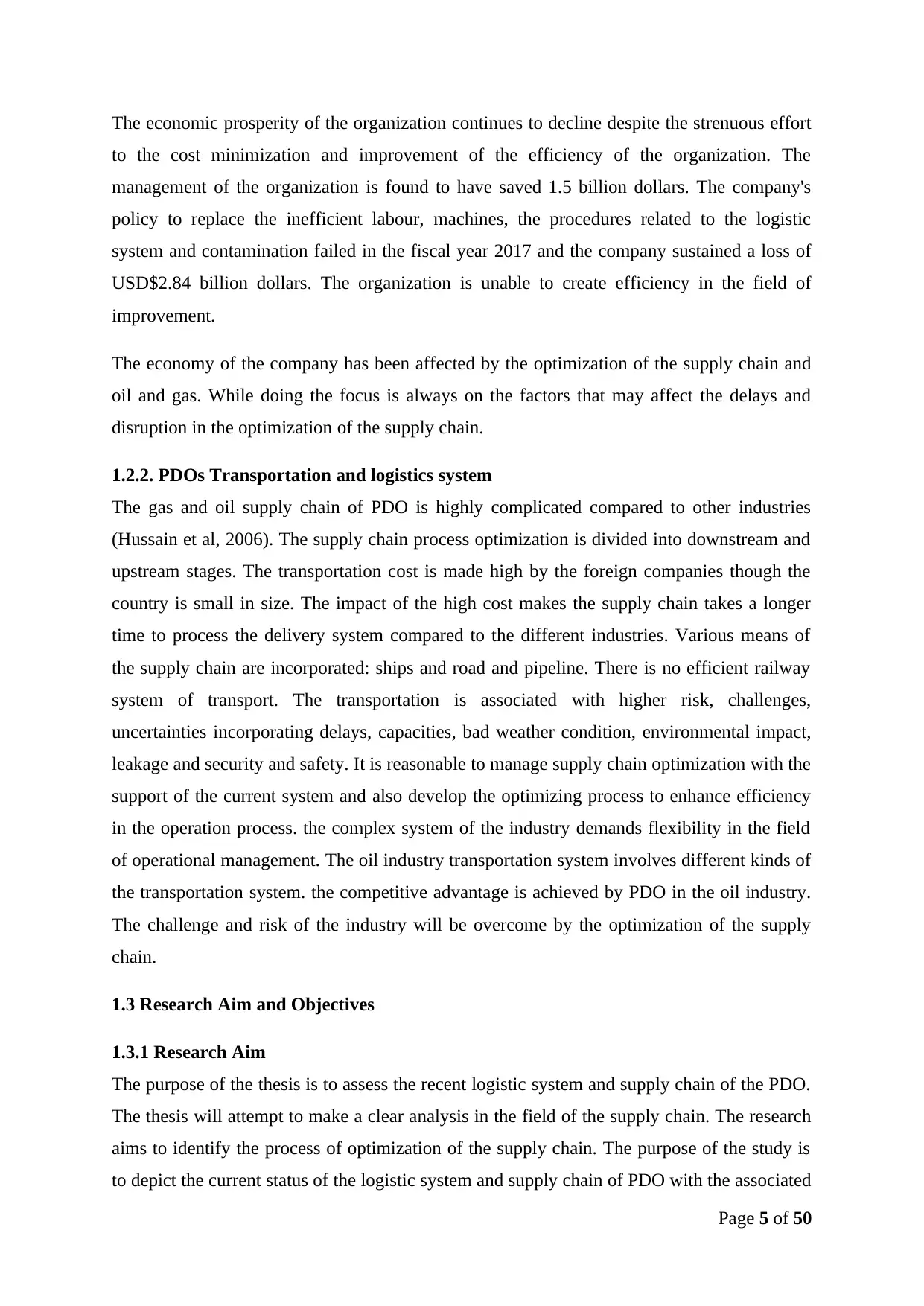
The economic prosperity of the organization continues to decline despite the strenuous effort
to the cost minimization and improvement of the efficiency of the organization. The
management of the organization is found to have saved 1.5 billion dollars. The company's
policy to replace the inefficient labour, machines, the procedures related to the logistic
system and contamination failed in the fiscal year 2017 and the company sustained a loss of
USD$2.84 billion dollars. The organization is unable to create efficiency in the field of
improvement.
The economy of the company has been affected by the optimization of the supply chain and
oil and gas. While doing the focus is always on the factors that may affect the delays and
disruption in the optimization of the supply chain.
1.2.2. PDOs Transportation and logistics system
The gas and oil supply chain of PDO is highly complicated compared to other industries
(Hussain et al, 2006). The supply chain process optimization is divided into downstream and
upstream stages. The transportation cost is made high by the foreign companies though the
country is small in size. The impact of the high cost makes the supply chain takes a longer
time to process the delivery system compared to the different industries. Various means of
the supply chain are incorporated: ships and road and pipeline. There is no efficient railway
system of transport. The transportation is associated with higher risk, challenges,
uncertainties incorporating delays, capacities, bad weather condition, environmental impact,
leakage and security and safety. It is reasonable to manage supply chain optimization with the
support of the current system and also develop the optimizing process to enhance efficiency
in the operation process. the complex system of the industry demands flexibility in the field
of operational management. The oil industry transportation system involves different kinds of
the transportation system. the competitive advantage is achieved by PDO in the oil industry.
The challenge and risk of the industry will be overcome by the optimization of the supply
chain.
1.3 Research Aim and Objectives
1.3.1 Research Aim
The purpose of the thesis is to assess the recent logistic system and supply chain of the PDO.
The thesis will attempt to make a clear analysis in the field of the supply chain. The research
aims to identify the process of optimization of the supply chain. The purpose of the study is
to depict the current status of the logistic system and supply chain of PDO with the associated
Page 5 of 50
to the cost minimization and improvement of the efficiency of the organization. The
management of the organization is found to have saved 1.5 billion dollars. The company's
policy to replace the inefficient labour, machines, the procedures related to the logistic
system and contamination failed in the fiscal year 2017 and the company sustained a loss of
USD$2.84 billion dollars. The organization is unable to create efficiency in the field of
improvement.
The economy of the company has been affected by the optimization of the supply chain and
oil and gas. While doing the focus is always on the factors that may affect the delays and
disruption in the optimization of the supply chain.
1.2.2. PDOs Transportation and logistics system
The gas and oil supply chain of PDO is highly complicated compared to other industries
(Hussain et al, 2006). The supply chain process optimization is divided into downstream and
upstream stages. The transportation cost is made high by the foreign companies though the
country is small in size. The impact of the high cost makes the supply chain takes a longer
time to process the delivery system compared to the different industries. Various means of
the supply chain are incorporated: ships and road and pipeline. There is no efficient railway
system of transport. The transportation is associated with higher risk, challenges,
uncertainties incorporating delays, capacities, bad weather condition, environmental impact,
leakage and security and safety. It is reasonable to manage supply chain optimization with the
support of the current system and also develop the optimizing process to enhance efficiency
in the operation process. the complex system of the industry demands flexibility in the field
of operational management. The oil industry transportation system involves different kinds of
the transportation system. the competitive advantage is achieved by PDO in the oil industry.
The challenge and risk of the industry will be overcome by the optimization of the supply
chain.
1.3 Research Aim and Objectives
1.3.1 Research Aim
The purpose of the thesis is to assess the recent logistic system and supply chain of the PDO.
The thesis will attempt to make a clear analysis in the field of the supply chain. The research
aims to identify the process of optimization of the supply chain. The purpose of the study is
to depict the current status of the logistic system and supply chain of PDO with the associated
Page 5 of 50
⊘ This is a preview!⊘
Do you want full access?
Subscribe today to unlock all pages.

Trusted by 1+ million students worldwide
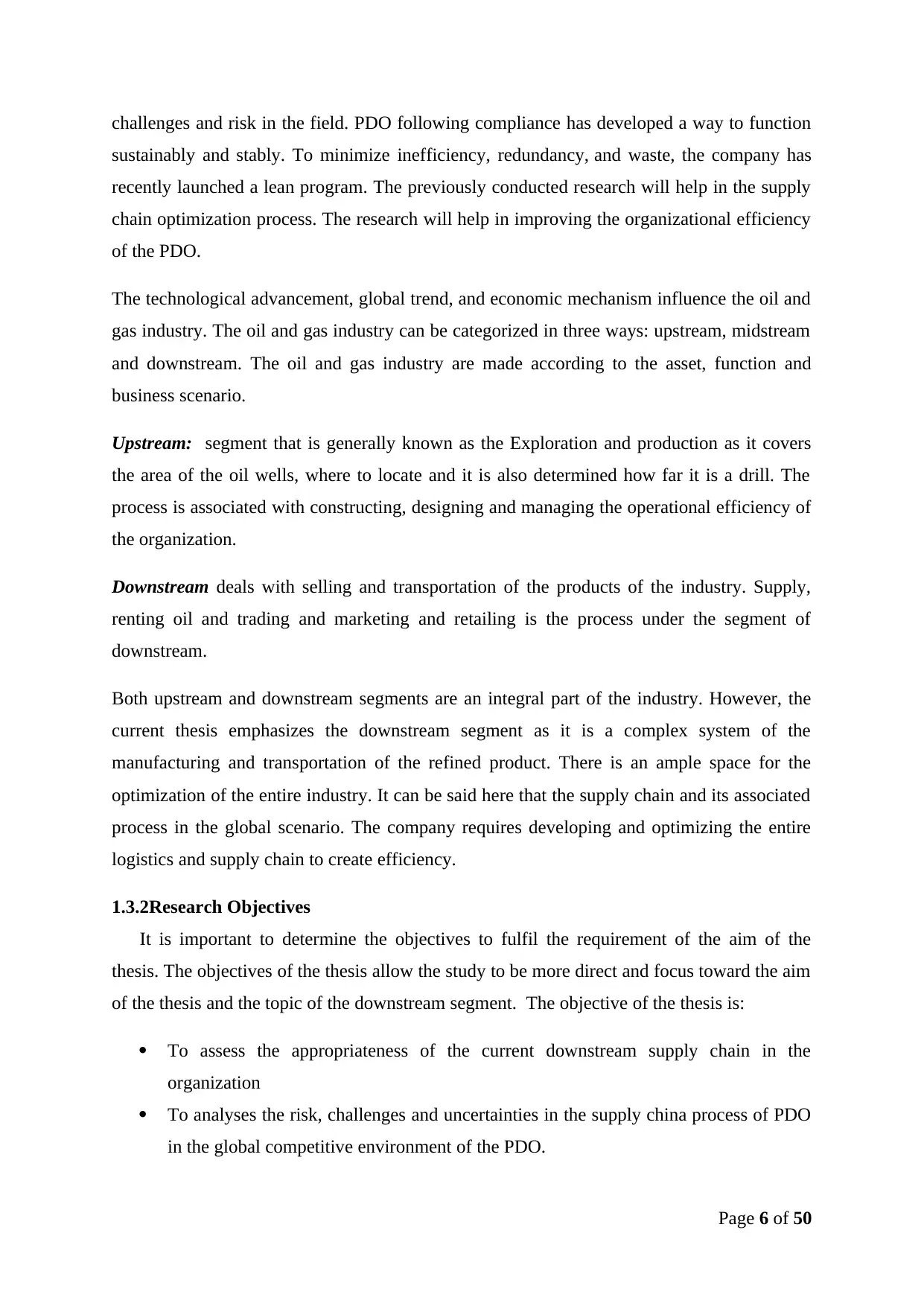
challenges and risk in the field. PDO following compliance has developed a way to function
sustainably and stably. To minimize inefficiency, redundancy, and waste, the company has
recently launched a lean program. The previously conducted research will help in the supply
chain optimization process. The research will help in improving the organizational efficiency
of the PDO.
The technological advancement, global trend, and economic mechanism influence the oil and
gas industry. The oil and gas industry can be categorized in three ways: upstream, midstream
and downstream. The oil and gas industry are made according to the asset, function and
business scenario.
Upstream: segment that is generally known as the Exploration and production as it covers
the area of the oil wells, where to locate and it is also determined how far it is a drill. The
process is associated with constructing, designing and managing the operational efficiency of
the organization.
Downstream deals with selling and transportation of the products of the industry. Supply,
renting oil and trading and marketing and retailing is the process under the segment of
downstream.
Both upstream and downstream segments are an integral part of the industry. However, the
current thesis emphasizes the downstream segment as it is a complex system of the
manufacturing and transportation of the refined product. There is an ample space for the
optimization of the entire industry. It can be said here that the supply chain and its associated
process in the global scenario. The company requires developing and optimizing the entire
logistics and supply chain to create efficiency.
1.3.2Research Objectives
It is important to determine the objectives to fulfil the requirement of the aim of the
thesis. The objectives of the thesis allow the study to be more direct and focus toward the aim
of the thesis and the topic of the downstream segment. The objective of the thesis is:
To assess the appropriateness of the current downstream supply chain in the
organization
To analyses the risk, challenges and uncertainties in the supply china process of PDO
in the global competitive environment of the PDO.
Page 6 of 50
sustainably and stably. To minimize inefficiency, redundancy, and waste, the company has
recently launched a lean program. The previously conducted research will help in the supply
chain optimization process. The research will help in improving the organizational efficiency
of the PDO.
The technological advancement, global trend, and economic mechanism influence the oil and
gas industry. The oil and gas industry can be categorized in three ways: upstream, midstream
and downstream. The oil and gas industry are made according to the asset, function and
business scenario.
Upstream: segment that is generally known as the Exploration and production as it covers
the area of the oil wells, where to locate and it is also determined how far it is a drill. The
process is associated with constructing, designing and managing the operational efficiency of
the organization.
Downstream deals with selling and transportation of the products of the industry. Supply,
renting oil and trading and marketing and retailing is the process under the segment of
downstream.
Both upstream and downstream segments are an integral part of the industry. However, the
current thesis emphasizes the downstream segment as it is a complex system of the
manufacturing and transportation of the refined product. There is an ample space for the
optimization of the entire industry. It can be said here that the supply chain and its associated
process in the global scenario. The company requires developing and optimizing the entire
logistics and supply chain to create efficiency.
1.3.2Research Objectives
It is important to determine the objectives to fulfil the requirement of the aim of the
thesis. The objectives of the thesis allow the study to be more direct and focus toward the aim
of the thesis and the topic of the downstream segment. The objective of the thesis is:
To assess the appropriateness of the current downstream supply chain in the
organization
To analyses the risk, challenges and uncertainties in the supply china process of PDO
in the global competitive environment of the PDO.
Page 6 of 50
Paraphrase This Document
Need a fresh take? Get an instant paraphrase of this document with our AI Paraphraser
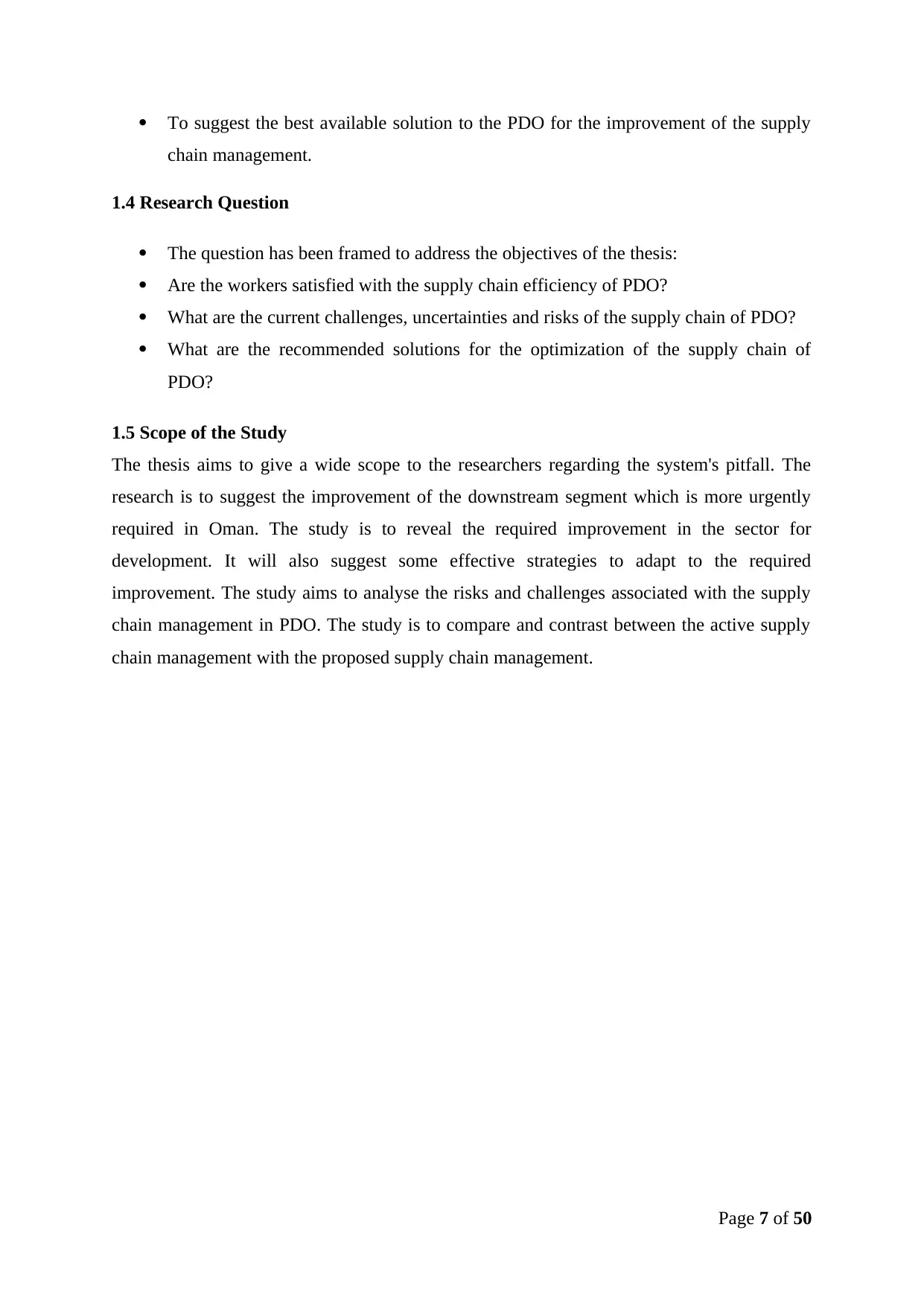
To suggest the best available solution to the PDO for the improvement of the supply
chain management.
1.4 Research Question
The question has been framed to address the objectives of the thesis:
Are the workers satisfied with the supply chain efficiency of PDO?
What are the current challenges, uncertainties and risks of the supply chain of PDO?
What are the recommended solutions for the optimization of the supply chain of
PDO?
1.5 Scope of the Study
The thesis aims to give a wide scope to the researchers regarding the system's pitfall. The
research is to suggest the improvement of the downstream segment which is more urgently
required in Oman. The study is to reveal the required improvement in the sector for
development. It will also suggest some effective strategies to adapt to the required
improvement. The study aims to analyse the risks and challenges associated with the supply
chain management in PDO. The study is to compare and contrast between the active supply
chain management with the proposed supply chain management.
Page 7 of 50
chain management.
1.4 Research Question
The question has been framed to address the objectives of the thesis:
Are the workers satisfied with the supply chain efficiency of PDO?
What are the current challenges, uncertainties and risks of the supply chain of PDO?
What are the recommended solutions for the optimization of the supply chain of
PDO?
1.5 Scope of the Study
The thesis aims to give a wide scope to the researchers regarding the system's pitfall. The
research is to suggest the improvement of the downstream segment which is more urgently
required in Oman. The study is to reveal the required improvement in the sector for
development. It will also suggest some effective strategies to adapt to the required
improvement. The study aims to analyse the risks and challenges associated with the supply
chain management in PDO. The study is to compare and contrast between the active supply
chain management with the proposed supply chain management.
Page 7 of 50
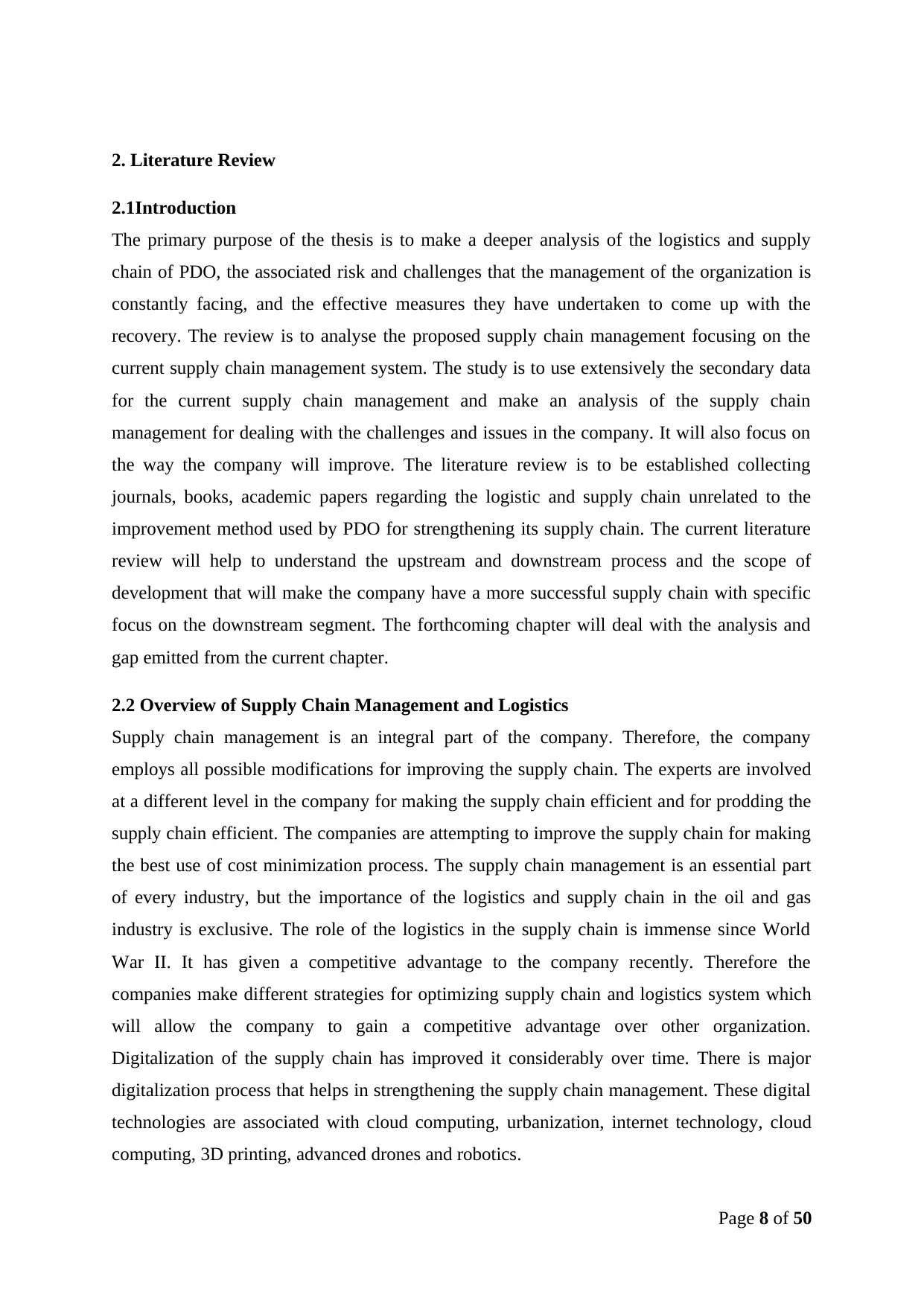
2. Literature Review
2.1Introduction
The primary purpose of the thesis is to make a deeper analysis of the logistics and supply
chain of PDO, the associated risk and challenges that the management of the organization is
constantly facing, and the effective measures they have undertaken to come up with the
recovery. The review is to analyse the proposed supply chain management focusing on the
current supply chain management system. The study is to use extensively the secondary data
for the current supply chain management and make an analysis of the supply chain
management for dealing with the challenges and issues in the company. It will also focus on
the way the company will improve. The literature review is to be established collecting
journals, books, academic papers regarding the logistic and supply chain unrelated to the
improvement method used by PDO for strengthening its supply chain. The current literature
review will help to understand the upstream and downstream process and the scope of
development that will make the company have a more successful supply chain with specific
focus on the downstream segment. The forthcoming chapter will deal with the analysis and
gap emitted from the current chapter.
2.2 Overview of Supply Chain Management and Logistics
Supply chain management is an integral part of the company. Therefore, the company
employs all possible modifications for improving the supply chain. The experts are involved
at a different level in the company for making the supply chain efficient and for prodding the
supply chain efficient. The companies are attempting to improve the supply chain for making
the best use of cost minimization process. The supply chain management is an essential part
of every industry, but the importance of the logistics and supply chain in the oil and gas
industry is exclusive. The role of the logistics in the supply chain is immense since World
War II. It has given a competitive advantage to the company recently. Therefore the
companies make different strategies for optimizing supply chain and logistics system which
will allow the company to gain a competitive advantage over other organization.
Digitalization of the supply chain has improved it considerably over time. There is major
digitalization process that helps in strengthening the supply chain management. These digital
technologies are associated with cloud computing, urbanization, internet technology, cloud
computing, 3D printing, advanced drones and robotics.
Page 8 of 50
2.1Introduction
The primary purpose of the thesis is to make a deeper analysis of the logistics and supply
chain of PDO, the associated risk and challenges that the management of the organization is
constantly facing, and the effective measures they have undertaken to come up with the
recovery. The review is to analyse the proposed supply chain management focusing on the
current supply chain management system. The study is to use extensively the secondary data
for the current supply chain management and make an analysis of the supply chain
management for dealing with the challenges and issues in the company. It will also focus on
the way the company will improve. The literature review is to be established collecting
journals, books, academic papers regarding the logistic and supply chain unrelated to the
improvement method used by PDO for strengthening its supply chain. The current literature
review will help to understand the upstream and downstream process and the scope of
development that will make the company have a more successful supply chain with specific
focus on the downstream segment. The forthcoming chapter will deal with the analysis and
gap emitted from the current chapter.
2.2 Overview of Supply Chain Management and Logistics
Supply chain management is an integral part of the company. Therefore, the company
employs all possible modifications for improving the supply chain. The experts are involved
at a different level in the company for making the supply chain efficient and for prodding the
supply chain efficient. The companies are attempting to improve the supply chain for making
the best use of cost minimization process. The supply chain management is an essential part
of every industry, but the importance of the logistics and supply chain in the oil and gas
industry is exclusive. The role of the logistics in the supply chain is immense since World
War II. It has given a competitive advantage to the company recently. Therefore the
companies make different strategies for optimizing supply chain and logistics system which
will allow the company to gain a competitive advantage over other organization.
Digitalization of the supply chain has improved it considerably over time. There is major
digitalization process that helps in strengthening the supply chain management. These digital
technologies are associated with cloud computing, urbanization, internet technology, cloud
computing, 3D printing, advanced drones and robotics.
Page 8 of 50
⊘ This is a preview!⊘
Do you want full access?
Subscribe today to unlock all pages.

Trusted by 1+ million students worldwide
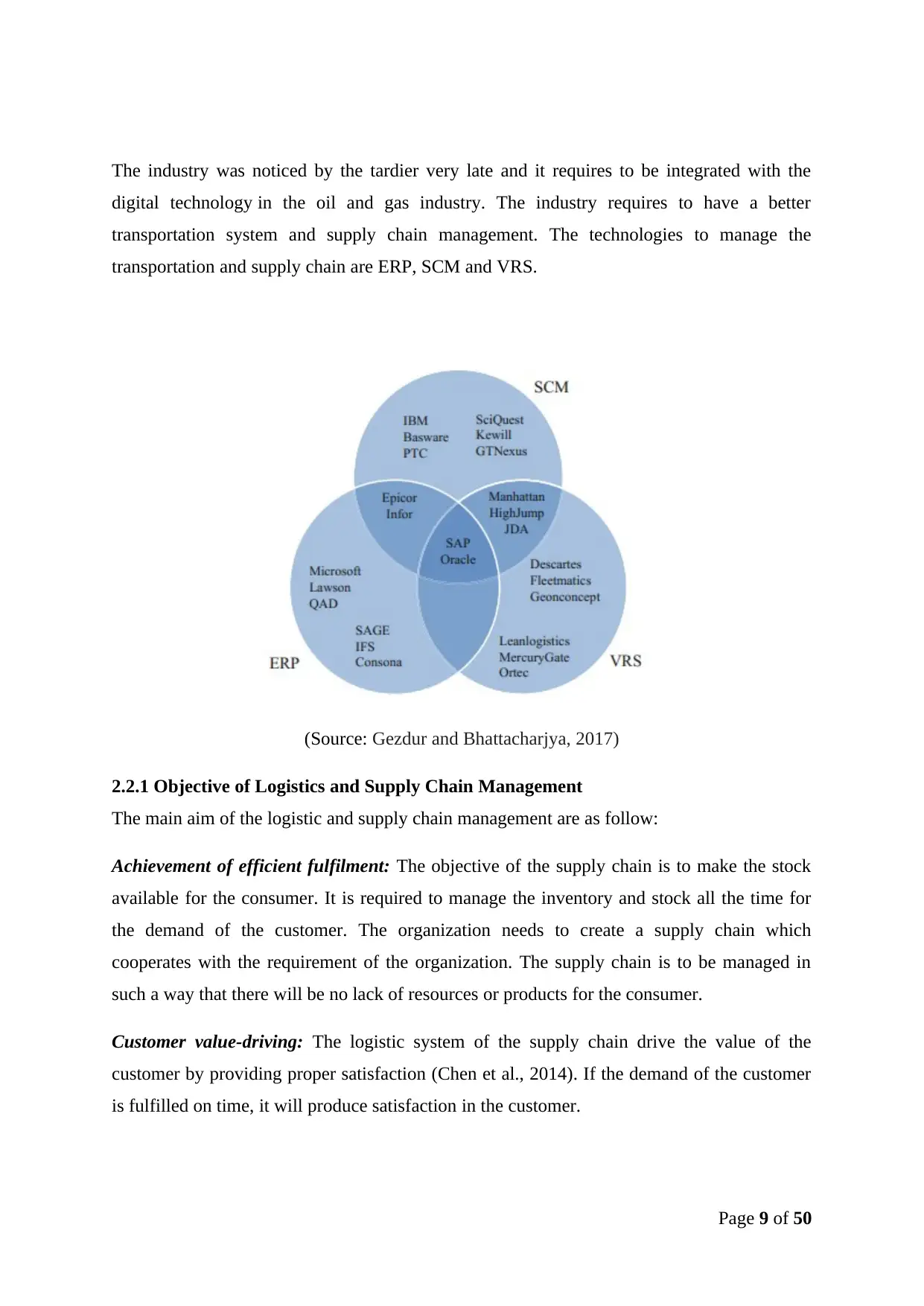
The industry was noticed by the tardier very late and it requires to be integrated with the
digital technology in the oil and gas industry. The industry requires to have a better
transportation system and supply chain management. The technologies to manage the
transportation and supply chain are ERP, SCM and VRS.
(Source: Gezdur and Bhattacharjya, 2017)
2.2.1 Objective of Logistics and Supply Chain Management
The main aim of the logistic and supply chain management are as follow:
Achievement of efficient fulfilment: The objective of the supply chain is to make the stock
available for the consumer. It is required to manage the inventory and stock all the time for
the demand of the customer. The organization needs to create a supply chain which
cooperates with the requirement of the organization. The supply chain is to be managed in
such a way that there will be no lack of resources or products for the consumer.
Customer value-driving: The logistic system of the supply chain drive the value of the
customer by providing proper satisfaction (Chen et al., 2014). If the demand of the customer
is fulfilled on time, it will produce satisfaction in the customer.
Page 9 of 50
digital technology in the oil and gas industry. The industry requires to have a better
transportation system and supply chain management. The technologies to manage the
transportation and supply chain are ERP, SCM and VRS.
(Source: Gezdur and Bhattacharjya, 2017)
2.2.1 Objective of Logistics and Supply Chain Management
The main aim of the logistic and supply chain management are as follow:
Achievement of efficient fulfilment: The objective of the supply chain is to make the stock
available for the consumer. It is required to manage the inventory and stock all the time for
the demand of the customer. The organization needs to create a supply chain which
cooperates with the requirement of the organization. The supply chain is to be managed in
such a way that there will be no lack of resources or products for the consumer.
Customer value-driving: The logistic system of the supply chain drive the value of the
customer by providing proper satisfaction (Chen et al., 2014). If the demand of the customer
is fulfilled on time, it will produce satisfaction in the customer.
Page 9 of 50
Paraphrase This Document
Need a fresh take? Get an instant paraphrase of this document with our AI Paraphraser
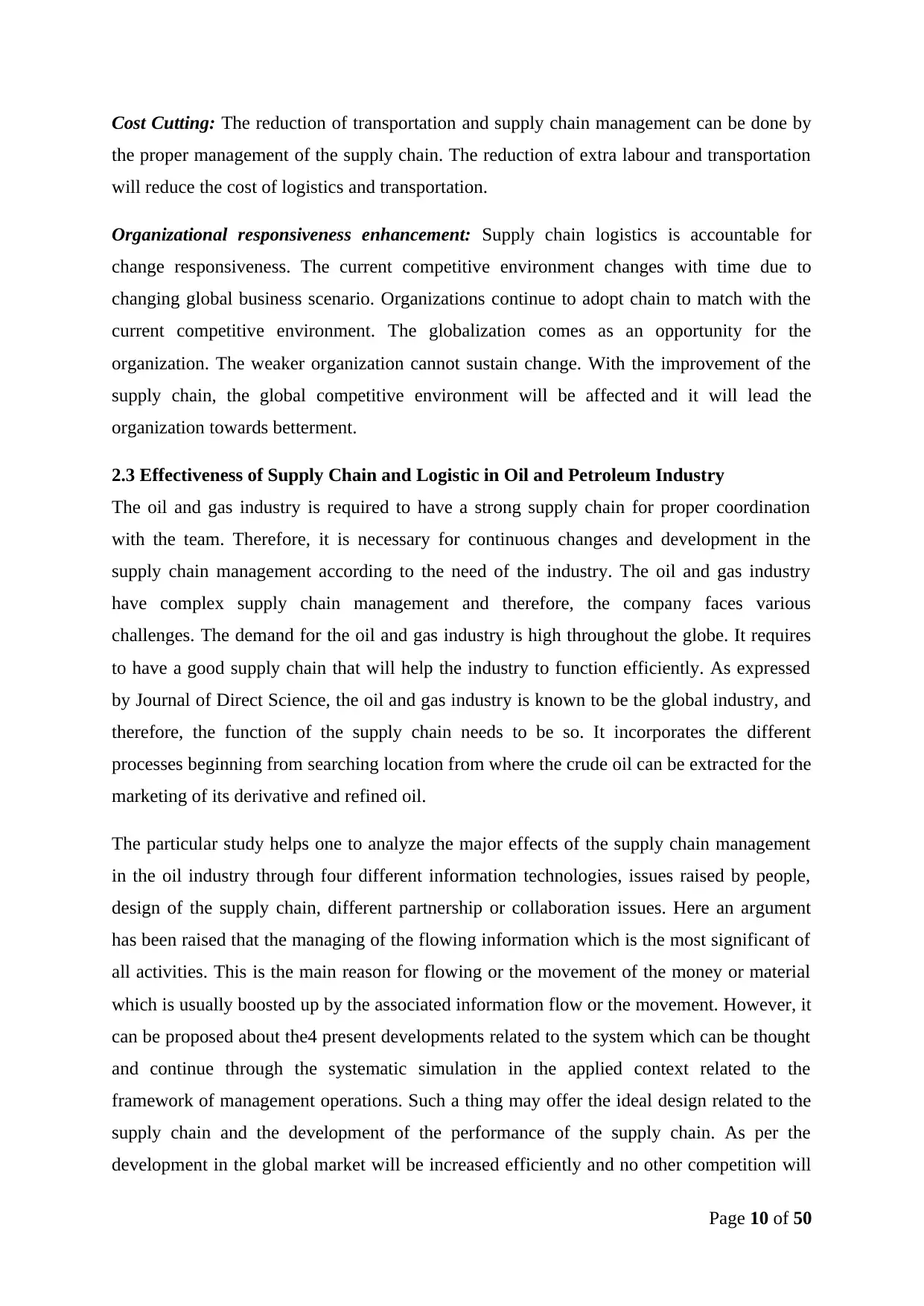
Cost Cutting: The reduction of transportation and supply chain management can be done by
the proper management of the supply chain. The reduction of extra labour and transportation
will reduce the cost of logistics and transportation.
Organizational responsiveness enhancement: Supply chain logistics is accountable for
change responsiveness. The current competitive environment changes with time due to
changing global business scenario. Organizations continue to adopt chain to match with the
current competitive environment. The globalization comes as an opportunity for the
organization. The weaker organization cannot sustain change. With the improvement of the
supply chain, the global competitive environment will be affected and it will lead the
organization towards betterment.
2.3 Effectiveness of Supply Chain and Logistic in Oil and Petroleum Industry
The oil and gas industry is required to have a strong supply chain for proper coordination
with the team. Therefore, it is necessary for continuous changes and development in the
supply chain management according to the need of the industry. The oil and gas industry
have complex supply chain management and therefore, the company faces various
challenges. The demand for the oil and gas industry is high throughout the globe. It requires
to have a good supply chain that will help the industry to function efficiently. As expressed
by Journal of Direct Science, the oil and gas industry is known to be the global industry, and
therefore, the function of the supply chain needs to be so. It incorporates the different
processes beginning from searching location from where the crude oil can be extracted for the
marketing of its derivative and refined oil.
The particular study helps one to analyze the major effects of the supply chain management
in the oil industry through four different information technologies, issues raised by people,
design of the supply chain, different partnership or collaboration issues. Here an argument
has been raised that the managing of the flowing information which is the most significant of
all activities. This is the main reason for flowing or the movement of the money or material
which is usually boosted up by the associated information flow or the movement. However, it
can be proposed about the4 present developments related to the system which can be thought
and continue through the systematic simulation in the applied context related to the
framework of management operations. Such a thing may offer the ideal design related to the
supply chain and the development of the performance of the supply chain. As per the
development in the global market will be increased efficiently and no other competition will
Page 10 of 50
the proper management of the supply chain. The reduction of extra labour and transportation
will reduce the cost of logistics and transportation.
Organizational responsiveness enhancement: Supply chain logistics is accountable for
change responsiveness. The current competitive environment changes with time due to
changing global business scenario. Organizations continue to adopt chain to match with the
current competitive environment. The globalization comes as an opportunity for the
organization. The weaker organization cannot sustain change. With the improvement of the
supply chain, the global competitive environment will be affected and it will lead the
organization towards betterment.
2.3 Effectiveness of Supply Chain and Logistic in Oil and Petroleum Industry
The oil and gas industry is required to have a strong supply chain for proper coordination
with the team. Therefore, it is necessary for continuous changes and development in the
supply chain management according to the need of the industry. The oil and gas industry
have complex supply chain management and therefore, the company faces various
challenges. The demand for the oil and gas industry is high throughout the globe. It requires
to have a good supply chain that will help the industry to function efficiently. As expressed
by Journal of Direct Science, the oil and gas industry is known to be the global industry, and
therefore, the function of the supply chain needs to be so. It incorporates the different
processes beginning from searching location from where the crude oil can be extracted for the
marketing of its derivative and refined oil.
The particular study helps one to analyze the major effects of the supply chain management
in the oil industry through four different information technologies, issues raised by people,
design of the supply chain, different partnership or collaboration issues. Here an argument
has been raised that the managing of the flowing information which is the most significant of
all activities. This is the main reason for flowing or the movement of the money or material
which is usually boosted up by the associated information flow or the movement. However, it
can be proposed about the4 present developments related to the system which can be thought
and continue through the systematic simulation in the applied context related to the
framework of management operations. Such a thing may offer the ideal design related to the
supply chain and the development of the performance of the supply chain. As per the
development in the global market will be increased efficiently and no other competition will
Page 10 of 50
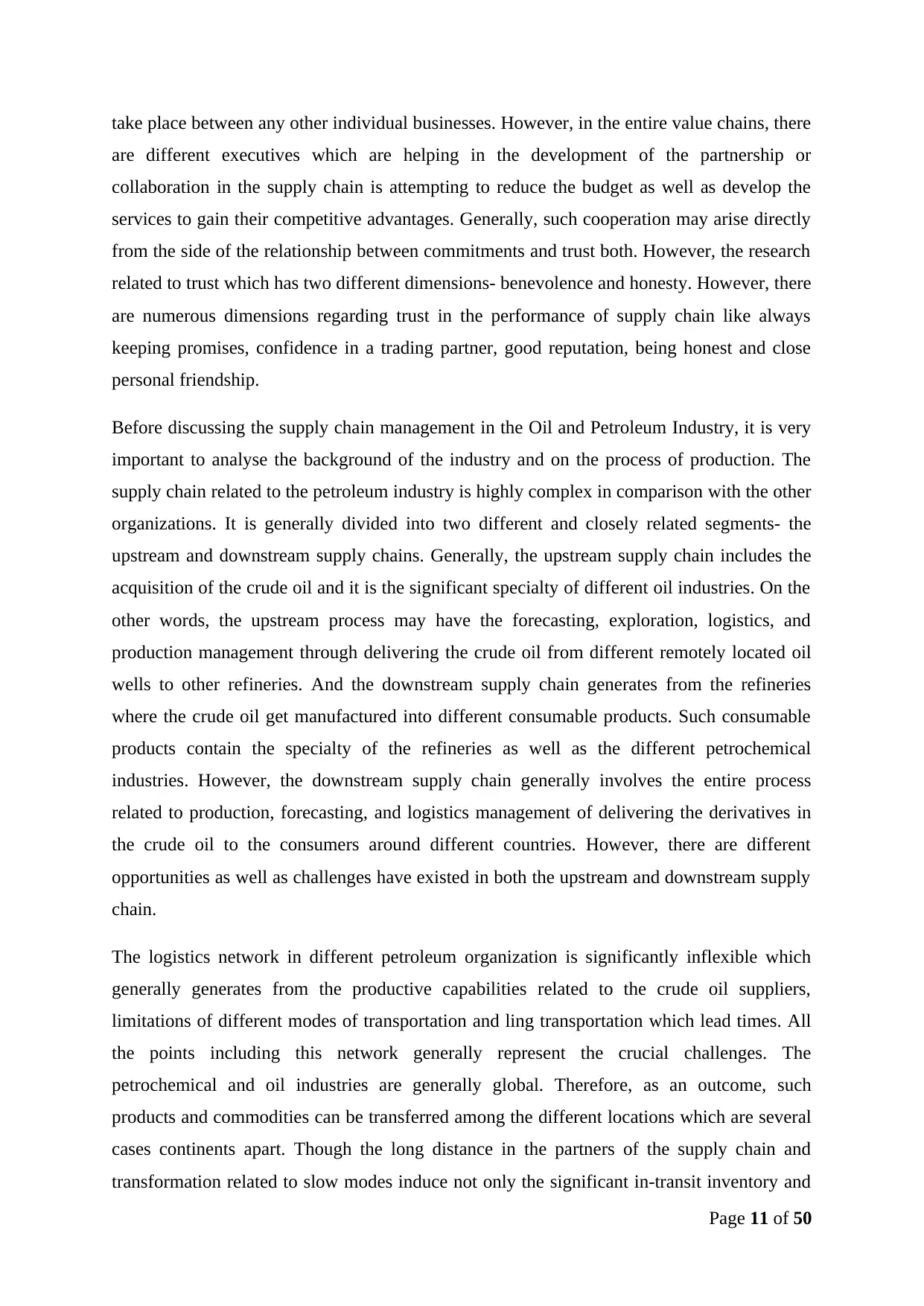
take place between any other individual businesses. However, in the entire value chains, there
are different executives which are helping in the development of the partnership or
collaboration in the supply chain is attempting to reduce the budget as well as develop the
services to gain their competitive advantages. Generally, such cooperation may arise directly
from the side of the relationship between commitments and trust both. However, the research
related to trust which has two different dimensions- benevolence and honesty. However, there
are numerous dimensions regarding trust in the performance of supply chain like always
keeping promises, confidence in a trading partner, good reputation, being honest and close
personal friendship.
Before discussing the supply chain management in the Oil and Petroleum Industry, it is very
important to analyse the background of the industry and on the process of production. The
supply chain related to the petroleum industry is highly complex in comparison with the other
organizations. It is generally divided into two different and closely related segments- the
upstream and downstream supply chains. Generally, the upstream supply chain includes the
acquisition of the crude oil and it is the significant specialty of different oil industries. On the
other words, the upstream process may have the forecasting, exploration, logistics, and
production management through delivering the crude oil from different remotely located oil
wells to other refineries. And the downstream supply chain generates from the refineries
where the crude oil get manufactured into different consumable products. Such consumable
products contain the specialty of the refineries as well as the different petrochemical
industries. However, the downstream supply chain generally involves the entire process
related to production, forecasting, and logistics management of delivering the derivatives in
the crude oil to the consumers around different countries. However, there are different
opportunities as well as challenges have existed in both the upstream and downstream supply
chain.
The logistics network in different petroleum organization is significantly inflexible which
generally generates from the productive capabilities related to the crude oil suppliers,
limitations of different modes of transportation and ling transportation which lead times. All
the points including this network generally represent the crucial challenges. The
petrochemical and oil industries are generally global. Therefore, as an outcome, such
products and commodities can be transferred among the different locations which are several
cases continents apart. Though the long distance in the partners of the supply chain and
transformation related to slow modes induce not only the significant in-transit inventory and
Page 11 of 50
are different executives which are helping in the development of the partnership or
collaboration in the supply chain is attempting to reduce the budget as well as develop the
services to gain their competitive advantages. Generally, such cooperation may arise directly
from the side of the relationship between commitments and trust both. However, the research
related to trust which has two different dimensions- benevolence and honesty. However, there
are numerous dimensions regarding trust in the performance of supply chain like always
keeping promises, confidence in a trading partner, good reputation, being honest and close
personal friendship.
Before discussing the supply chain management in the Oil and Petroleum Industry, it is very
important to analyse the background of the industry and on the process of production. The
supply chain related to the petroleum industry is highly complex in comparison with the other
organizations. It is generally divided into two different and closely related segments- the
upstream and downstream supply chains. Generally, the upstream supply chain includes the
acquisition of the crude oil and it is the significant specialty of different oil industries. On the
other words, the upstream process may have the forecasting, exploration, logistics, and
production management through delivering the crude oil from different remotely located oil
wells to other refineries. And the downstream supply chain generates from the refineries
where the crude oil get manufactured into different consumable products. Such consumable
products contain the specialty of the refineries as well as the different petrochemical
industries. However, the downstream supply chain generally involves the entire process
related to production, forecasting, and logistics management of delivering the derivatives in
the crude oil to the consumers around different countries. However, there are different
opportunities as well as challenges have existed in both the upstream and downstream supply
chain.
The logistics network in different petroleum organization is significantly inflexible which
generally generates from the productive capabilities related to the crude oil suppliers,
limitations of different modes of transportation and ling transportation which lead times. All
the points including this network generally represent the crucial challenges. The
petrochemical and oil industries are generally global. Therefore, as an outcome, such
products and commodities can be transferred among the different locations which are several
cases continents apart. Though the long distance in the partners of the supply chain and
transformation related to slow modes induce not only the significant in-transit inventory and
Page 11 of 50
⊘ This is a preview!⊘
Do you want full access?
Subscribe today to unlock all pages.

Trusted by 1+ million students worldwide
1 out of 48
Related Documents
Your All-in-One AI-Powered Toolkit for Academic Success.
+13062052269
info@desklib.com
Available 24*7 on WhatsApp / Email
![[object Object]](/_next/static/media/star-bottom.7253800d.svg)
Unlock your academic potential
Copyright © 2020–2025 A2Z Services. All Rights Reserved. Developed and managed by ZUCOL.





